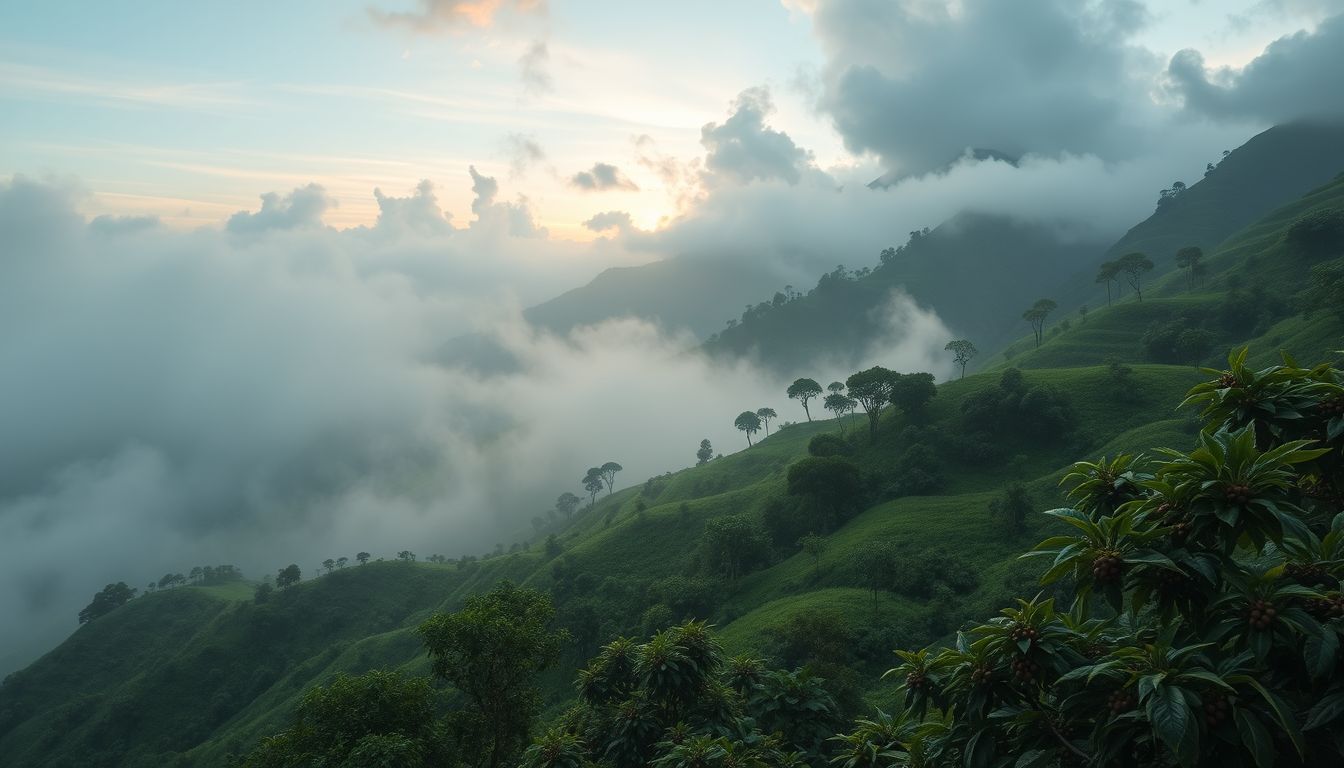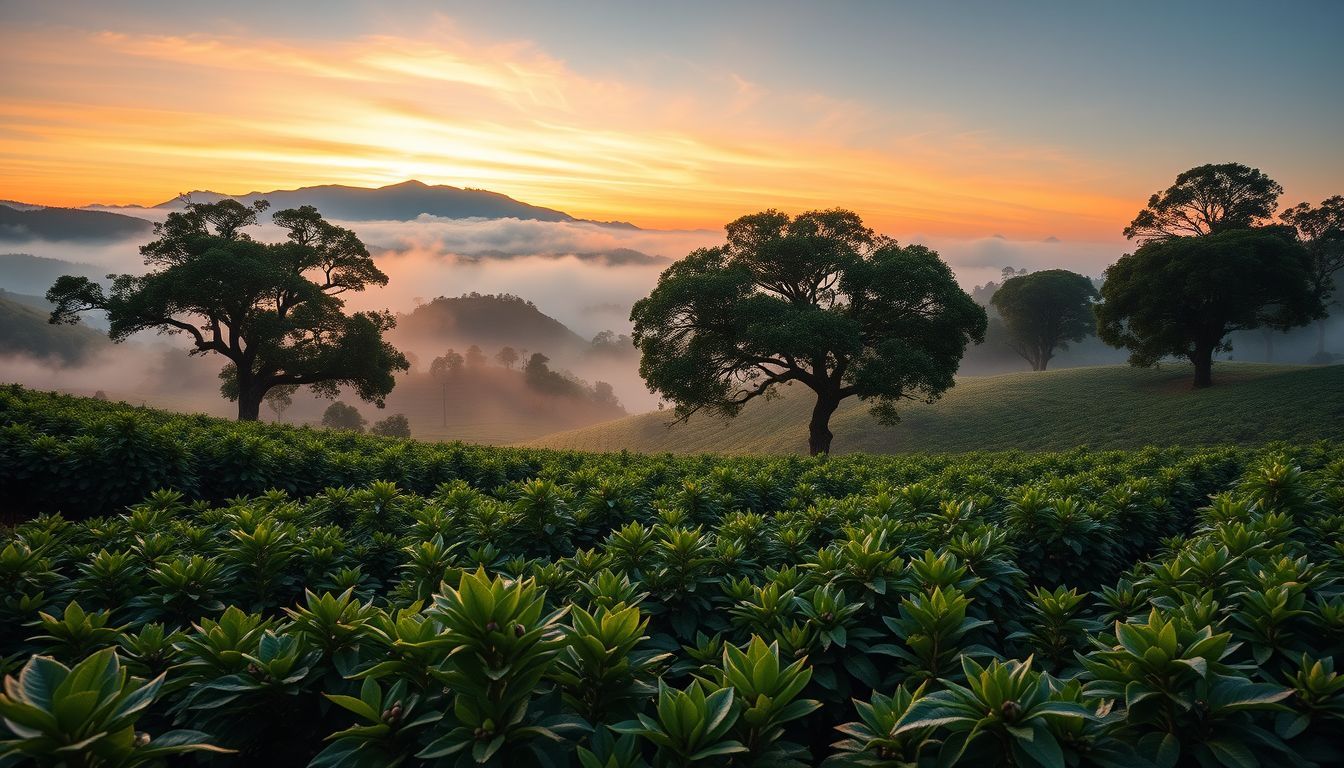The impact of altitude on coffee bean development and flavor profiles
Journey through the vertical landscapes where coffee grows, discovering how elevation shapes every nuance of flavor from the mountain's whispered secrets to your morning cup.

The Impact of Altitude on Coffee Bean Development and Flavor Profiles
There's something almost mystical about standing on a mountainside coffee farm at dawn, watching the mist roll through terraced rows of coffee plants as the first light touches the highest peaks. The air is thin here, crisp with possibility, and every breath reminds you that you're witnessing something extraordinary—the slow, deliberate dance between elevation and flavor that has been unfolding for centuries.
As a coffee origin specialist, I've walked these high-altitude paths from the volcanic slopes of Guatemala to the cloud forests of Ethiopia, and each journey has deepened my understanding of a fundamental truth: altitude doesn't just grow coffee—it sculpts it, shapes it, and ultimately transforms it into something that speaks of its place in the vertical world.
The Vertical Terroir: Understanding Coffee's Relationship with Elevation
When we speak of terroir in coffee, we often think of soil composition, rainfall patterns, and temperature variations. But perhaps no single factor influences the development of coffee beans quite like altitude. The relationship between elevation and coffee is one of beautiful complexity, where every meter gained brings new challenges and new possibilities for flavor development.
Coffee grows in what we call the "coffee belt"—that band around the equator between 25 degrees north and 30 degrees south latitude. But within this belt, it's the vertical dimension that truly matters. From sea level to over 2,000 meters above, coffee plants adapt, struggle, and ultimately reward us with beans that carry the signature of their elevation in every cell.
The Science of Slow Growth
At higher altitudes, coffee plants face a fundamental challenge: cooler temperatures slow down their entire life cycle. What might seem like a disadvantage is actually nature's way of creating complexity. The cooler air means that coffee cherries take longer to ripen—sometimes several months longer than their low-altitude cousins.
This extended maturation period is like allowing a fine wine to age. The sugars have more time to develop and concentrate within the bean. The cellular structure becomes denser, creating what we call "hard bean" coffee—beans that are literally more compact and substantial than those grown at lower elevations.
I remember visiting a farm in the Huehuetenango region of Guatemala, where the farmer showed me two coffee cherries—one from his highest plot at 1,800 meters, another from a lower section at 1,200 meters. The difference was immediately apparent. The high-altitude cherry was smaller, denser, and when we cut it open, the bean inside had a deeper, more vibrant color and a noticeably firmer texture.
The Flavor Architecture of Elevation
Low Altitude: The Foundation Notes (0-800 meters)
Coffee grown at lower elevations tends to develop what I think of as the "foundation notes" of coffee flavor. These beans often exhibit:
- Body-forward characteristics: Fuller, heavier mouthfeel
- Earthy undertones: Mineral and soil-driven flavors
- Nutty and chocolatey notes: Rich, comforting flavors that speak of warmth
- Lower acidity: Smooth, mellow profiles that are approachable and familiar
These coffees form the backbone of many blends, providing stability and richness. They're the steady bass notes in coffee's symphony, reliable and grounding.
Medium Altitude: The Harmony Zone (800-1,200 meters)
In this middle elevation range, coffee begins to sing in harmony. The beans develop:
- Balanced profiles: Neither too heavy nor too bright
- Caramel and brown sugar sweetness: Natural sugars that developed during the moderate maturation period
- Gentle acidity: Present but not overwhelming
- Versatile character: Excellent for both single origins and blending
I often think of medium-altitude coffees as the diplomatic ambassadors of the coffee world—they speak to everyone and offend no one, while still maintaining their own distinct personality.
High Altitude: The Soprano Notes (1,200-2,000+ meters)
This is where coffee truly begins to soar. High-altitude beans are the sopranos of the coffee world, capable of hitting notes that lower-grown coffees simply cannot reach:
- Bright, vibrant acidity: The hallmark of high-altitude coffee
- Floral and fruity notes: Delicate aromatics that dance on the palate
- Wine-like complexity: Layered flavors that evolve as the coffee cools
- Clean finish: Crisp, clear aftertastes that linger pleasantly
The Environmental Orchestra: How Altitude Conducts Flavor
Temperature Variations and Diurnal Shifts
At higher elevations, the daily temperature swings become more dramatic. Days might be warm and sunny, but nights can be surprisingly cool. This diurnal temperature variation is like a natural stress that encourages the coffee plant to produce more complex compounds as a survival mechanism.
The plant essentially "works harder" to maintain its cellular integrity through these temperature fluctuations, and this effort translates directly into more concentrated flavors and aromatic compounds in the beans.
Atmospheric Pressure and Oxygen Levels
The thinner air at high altitudes means lower atmospheric pressure and reduced oxygen levels. While this might challenge human visitors (I've certainly felt the effects during my mountain farm visits), coffee plants have adapted to these conditions over generations.
The reduced oxygen actually slows down certain metabolic processes in the plant, contributing to that crucial extended maturation period. It's as if the mountain itself is teaching the coffee plant patience, and that patience is rewarded with complexity.
UV Radiation and Plant Stress
Higher altitudes mean increased exposure to UV radiation. Coffee plants respond to this stress by producing more antioxidants and protective compounds—many of which contribute directly to flavor development. The plant's natural defense mechanisms become part of what we taste in the cup.
Regional Expressions: Altitude Across Origins
Ethiopian Highlands: Where Coffee Began Its Vertical Journey
In Ethiopia's high-altitude regions like Yirgacheffe and Sidamo (1,800-2,200 meters), coffee exhibits an almost ethereal quality. The combination of ancient varietals, high elevation, and traditional processing methods creates coffees with:
- Intense floral aromatics
- Tea-like body with wine-like acidity
- Complex fruit notes ranging from citrus to stone fruits
- A clarity that seems to capture the mountain air itself
Central American Peaks: Volcanic Soil Meets High Altitude
The volcanic mountains of Guatemala, Costa Rica, and Panama offer a unique combination of mineral-rich soils and extreme elevations. Here, altitude works in partnership with volcanic terroir to create:
- Bright acidity balanced by volcanic minerality
- Chocolate and spice notes from the rich soil
- Exceptional clarity and definition in flavor
- Complex fruit notes that speak of tropical highland conditions
Andean Heights: South America's Vertical Coffee Gardens
From Colombia's Cordillera to Peru's mountain slopes, the Andes provide some of the world's most dramatic coffee-growing elevations. These high-altitude South American coffees often display:
- Caramel sweetness balanced by bright acidity
- Tropical fruit notes with underlying chocolate
- Clean, crisp finishes that reflect the mountain air
- Exceptional balance that comes from optimal growing conditions
The Art of Processing at Altitude
Altitude doesn't just affect how coffee grows—it also influences how it's processed. The cooler temperatures and lower humidity at high elevations create ideal conditions for certain processing methods:
Natural Processing in the Mountains
The dry, cool air of high-altitude regions allows for extended natural processing, where coffee cherries dry slowly and evenly. This extended drying period can enhance fruit flavors and create more complex fermentation profiles.
Washed Processing Precision
The cooler temperatures also allow for more controlled fermentation during washed processing, leading to cleaner, brighter flavor profiles that showcase the inherent characteristics developed during the bean's high-altitude growth.
Brewing the Vertical Dimension
When brewing high-altitude coffees, I often adjust my approach to honor the complexity that elevation has created:
- Water temperature: Slightly cooler water (195-200°F) to preserve delicate aromatics
- Grind size: Often slightly coarser to allow for proper extraction without over-extracting bitter compounds
- Brewing time: Extended contact time to fully develop the complex flavors
- Ratio adjustments: Sometimes using a higher coffee-to-water ratio to capture the full intensity of high-altitude beans
The Future of High-Altitude Coffee
As climate change continues to affect coffee-growing regions worldwide, altitude becomes increasingly important. Many farmers are moving their cultivation higher up the mountains, seeking the cooler temperatures that their coffee plants need to thrive.
This vertical migration of coffee cultivation is creating new opportunities for flavor development while also presenting new challenges. Farmers are pioneering cultivation techniques for previously unsuitable elevations, and we're discovering new expressions of coffee flavor as a result.
Conclusion: Tasting the Mountain's Gift
Every time I cup a high-altitude coffee, I'm reminded of those misty mountain mornings and the patient work of farmers who tend their crops in the thin air of the world's peaks. Altitude is more than just a number on a coffee bag—it's a story of adaptation, patience, and the remarkable ability of the coffee plant to transform environmental challenges into flavor gifts.
The next time you taste a bright, complex coffee with notes that seem to dance and evolve in your cup, take a moment to consider the vertical journey that created those flavors. From the slow ripening in cool mountain air to the dense cellular structure that developed under atmospheric pressure, every sip carries the signature of elevation.
In coffee, as in life, sometimes we must climb higher to discover what's truly possible. The mountains have been teaching coffee this lesson for centuries, and every cup of high-altitude coffee is an invitation to taste that ancient wisdom—one carefully cultivated, slowly developed, beautifully complex sip at a time.
The relationship between altitude and coffee is ultimately a love story—a tale of how the earth's vertical dimension embraces the coffee plant, challenges it, shapes it, and ultimately transforms it into something that speaks of its lofty origins with every aromatic breath and every flavorful note. It's a reminder that in coffee, as in the mountains themselves, the most extraordinary discoveries often await us at the highest elevations.

Ben Carter
I spent the first part of my life learning the language of the wild—the rustle of leaves, the silence of snow, the resilience of a lone tree. In my writing, I try to translate that language, exploring how the landscapes around us shape the landscapes within us. My stories are quiet, but I hope they speak to a deeper part of you.


